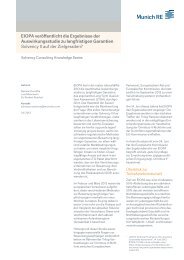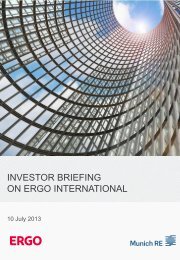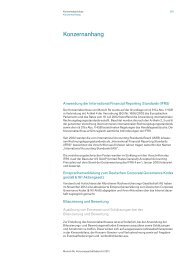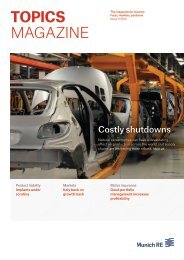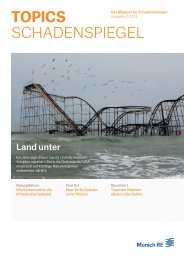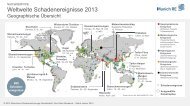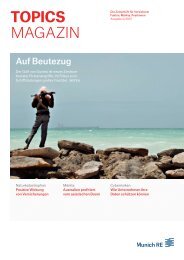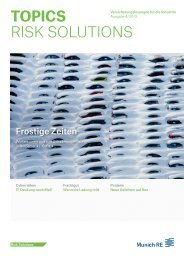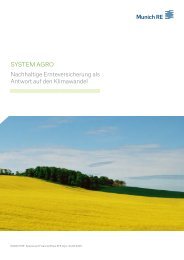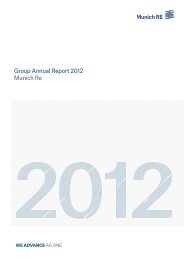Munich Re Group Annual Report 2006 (PDF, 1.8
Munich Re Group Annual Report 2006 (PDF, 1.8
Munich Re Group Annual Report 2006 (PDF, 1.8
Create successful ePaper yourself
Turn your PDF publications into a flip-book with our unique Google optimized e-Paper software.
<strong>Munich</strong> <strong>Re</strong> <strong>Group</strong> <strong>Annual</strong> <strong>Re</strong>port <strong>2006</strong> Notes_Assets<br />
Assets<br />
A Intangible assets<br />
ings attributable to the <strong>Group</strong> are included in the investment result.<br />
In accordance with IFRS 3, goodwill from the first-time consolidation As a rule, the most recent individual or consolidated financial state-<br />
of subsidiaries is tested for impairment at least once annually, i.e. ments of the associate are used; exceptional transactions of material<br />
the carrying amount of goodwill is compared with the recoverable importance for a true and fair picture of the associate’s financial<br />
amount and, if this recoverable amount is lower, a write-down is position are recognised in the same financial year. Investments in<br />
made for impairment equivalent to the amount of the difference. associates that are assessed as not being material for assessing the<br />
Other intangible assets mainly comprise purchased and internally <strong>Group</strong>’s financial position are accounted for at fair value insofar as<br />
generated software and acquired insurance portfolios. The software this can be reliably measured. To determine the fair value, we use the<br />
is carried at cost less straight-line amortisation. The useful life<br />
share prices at the balance sheet date if the investments are quoted<br />
assumed is generally three to five years, in exceptional cases up to on a stock exchange; for other investments, the fair value is meas-<br />
ten years. Acquired insurance portfolios are recognised at their presured using the discounted earnings approach or the net asset value<br />
ent value on acquisition (PVFP: present value of future profits). This method.<br />
is determined as the present value of expected profits from the port- Loans are non-derivative financial assets with fixed or deterfolio<br />
acquired, without consideration of new business and tax<br />
minable payments that are not quoted in an active market. They<br />
effects. The items in question are amortised in accordance with the are carried at cost in accordance with the effective interest method.<br />
realisation of the profits from the insurance portfolios underlying the Write-downs for impairments are made in cases where the repay-<br />
PVFP calculation. The other intangible assets are tested for impairment of a loan can no longer be expected.<br />
ment at each balance sheet date and write-downs made if required. Fixed-interest securities held to maturity are measured at amor-<br />
Write-downs of software and other intangible assets are distributed tised cost.<br />
in the consolidated income statement between investment expenses, Fixed-interest or non-fixed-interest securities available for sale<br />
expenses for claims and benefits and operating expenses. If it is not and not held for trading or recognised under loans are accounted for<br />
possible to allocate the expenses to these functional areas, they are at fair value. The relevant unrealised gains or losses are calculated<br />
shown under “other expenses”. Write-downs of purchased insur- taking into account interest accrued and, after deduction of deferred<br />
ance portfolios are recognised under operating expenses. Write-ups taxes and the amounts apportionable to policyholders by the life and<br />
of software and other intangible assets are included in “other<br />
health insurers on realisation (provision for deferred premium<br />
income”.<br />
refunds), are recognised directly in equity.<br />
Securities held for trading comprise all fixed-interest and non-<br />
B Investments<br />
fixed-interest securities that we have acquired for trading purposes<br />
Land and buildings shown under investments comprise property to earn short-term profits from price changes and differences; in<br />
used by third parties and are carried at cost. Maintenance expenses addition, they include all derivative financial instruments (deriva-<br />
are recognised as an expense. Structural measures equivalent to 5% tives) with positive fair values which we have acquired for hedging<br />
or more of the historical cost of a building are generally assessed purposes but which do not meet the strict requirements of IAS 39 for<br />
with regard to whether they have to be capitalised. Buildings are hedge accounting. Securities held for trading are accounted for at<br />
depreciated on a straight-line basis in accordance with the compon- fair value at the balance sheet date. If there are no stock market<br />
ent approach over 40 to 55 years, depending on the weighted useful prices available, fair values (particularly with derivatives) are based<br />
life for their specific building class. If the recoverable amount of land on recognised valuation methods. All unrealised gains or losses<br />
and buildings falls below their carrying amount, the carrying amount from such valuation are included in the investment result.<br />
is written down to the recoverable amount. Impairment losses are Deposits retained on assumed reinsurance are receivables from<br />
recognised as investment expense in the consolidated income state- our cedants for cash deposits that have been retained under the<br />
ment, and reversals of impairment losses as investment income. terms of reinsurance agreements; they are accounted for at face<br />
Land and buildings classified as “held for sale” are recognised at the value.<br />
lower of book value or fair value less sales costs.<br />
Other investments are measured at amortised cost. Financial<br />
Investments in affiliated companies that we do not consolidate assets in our direct portfolio are generally accounted for at the settle-<br />
because they are not material are carried at fair value insofar as this ment date. Investments held in special funds are accounted for at the<br />
can be reliably measured. If the investments are quoted on a stock trade date.<br />
exchange, we use the share prices at the balance sheet date; for<br />
Securities that we lend by way of securities lending continue to be<br />
other investments, the fair value is measured using the discounted recognised in our balance sheet, as there is no transfer of risks and<br />
earnings or net asset value method. Changes in the fair value are rewards; securities that we have borrowed are accounted for by the<br />
recognised in “other reserves” under unrealised gains and losses. lender. Fees from securities lending are shown in the investment<br />
Investments in associates are valued by the equity method at the<br />
<strong>Group</strong>’s proportionate share of their net assets. The associate’s earnresult.<br />
159



